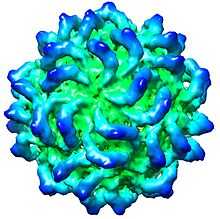Partitiviridae
| Partitiviridae | |
|---|---|
 | |
| CryoEM reconstruction of Penicillium stoloniferum virus S capsid, a partitivirus. EMDB entry EMD-5161[1] | |
| Virus classification | |
| Group: | Group III (dsRNA) |
| Family: | Partitiviridae |
| Genera | |
|
Alphacryptovirus | |
Partitiviridae are plant and fungi group III viruses with double stranded RNA genomes. Their name comes from the Latin partitius which means divided and they are called this as they have segmented genomes.
Taxonomy
There are several genera within the Partitiviridae family:
- Alphacryptovirus examples: White Clover Cryptic Virus 1 (WCCV-1) and Poinsettia cryptic virus (PnCV)
- Betacryptovirus example White Clover Cryptic Virus 2 (WCCV-2)
- Cryspovirus: type species—Cryptosporidium parvum virus 1
- Partitivirus example Atkinsonella hypoxylon virus (AhV)
Other members of the Alphacryptovirus include Citrullus lanatus cryptic virus, Pepper cryptic virus 1 and Raphanus sativus cryptic virus.
Partitiviruses mainly infect fungi whereas Alphacryptoviruses and Betacryptoviruses infect plants. The viruses are quite specific when it comes to their host and in plants they are generally transmitted by seeds. Fungal Partitiviruses are generally only transmitted vertically or by hyphal anastomosis. Until recently there was thought to be a fourth genus in this family, the Chrysovirus which infect fungi such as penicillium but they have formed their own family called Chrysoviridae which include the Penicillium chrysogenum virus.
Another genus has been described in this family—Cryspovirus. The viruses in this genus infect apicomplexian protozoa of the genus Cryptosporidium.[2]
Genome and Structure
Partitiviruses have double stranded RNA genomes divided into two genomic segments and there may be additional subgenomic segments. The genome segments are packaged in the same virus particle, the larger segment codes for the RNA-dependent RNA polymerase and the smaller codes for the coat protein. The total length of the genome is 3000–10000 nucleotides in length. The virus particle is non-enveloped and icosahedral with a diameter between 30–35 nm.
Phylogenetics
Based on the RNA polymerase gene this group can be divided into four clades (I-IV).[3] Four isolates from animals and protozoans form a fifth clade. Clades I-IV consist of mixtures of partitivirus-like sequences from plants and fungi.
References
- ↑ Tang, J.; Pan, J.; Havens, W. M.; Ochoa, W. F.; Guu, T. S. Y.; Ghabrial, S. A.; Nibert, M. L.; Tao, Y. J.; Baker, T. S. (2010). "Backbone Trace of Partitivirus Capsid Protein from Electron Cryomicroscopy and Homology Modeling". Biophysical Journal 99 (2): 685–694. doi:10.1016/j.bpj.2010.04.058. PMC 2905076. PMID 20643089.
- ↑ Nibert ML, Woods KM, Upton SJ, Ghabrial SA (2009) Cryspovirus: a new genus of protozoan viruses in the family Partitiviridae. Arch Virol 154(12):1959-1965
- ↑ Liu H, Fu Y, Xie J, Cheng J, Ghabrial SA, Li G, Yi X, Jiang D (2012) Discovery of Novel dsRNA Viral Sequences by In Silico Cloning and Implications for Viral Diversity, Host Range and Evolution. PLoS One. 2012;7(7):e42147.